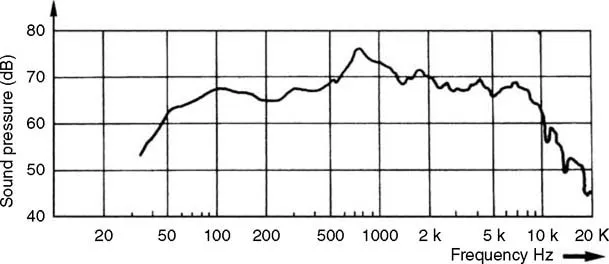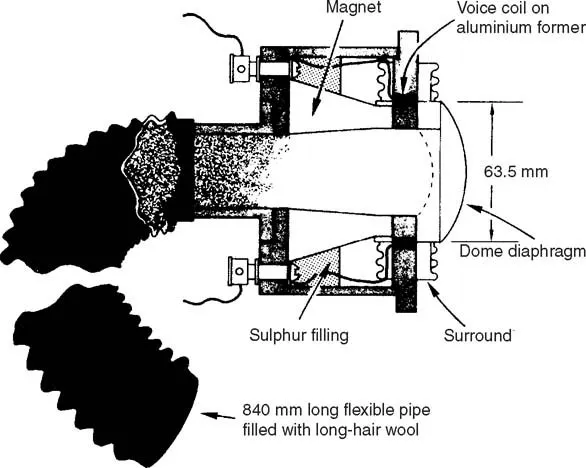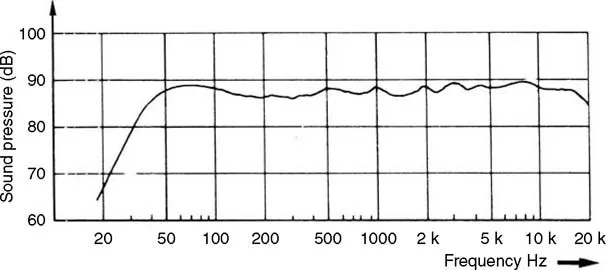![]()
1
General Review
Speech and music is noise with meaning. The recording and reproducing of sound is imperfect, the process reduces meaning and adds noise.
It is the art of the loudspeaker designer to use science to help increase meaning in reproduced sound. An understanding of music in all its forms is a vital criteria for the reasoned application of acoustical engineering to loudspeaker design.
It is now 80 years since the loudspeaker as we know it was first developed—an electrodynamic transducer of respectable loudness, of satisfactory and uniform amplitude versus frequency, reliable in use and with the potential for economic manufacture. Before this, there were only earphones of various kinds. Earlier, moving coil and cone speakers had been made; even Ernst Werner Siemens’ US patent of 1874 was one of these. Ironically, at that time, no electrical audio signals were available to drive it. The familiar moving-coil cone loudspeaker, whose principle is so effective that its key elements have remained essentially unchanged to this day, came with ‘the New Hornless Loudspeaker’ of 1925 by Rice and Kellogg of GE (US), which set the stage for the mass controlled, low-resonant frequency form we know so well, a driver where at least part of the frequency response is fundamentally uniform with frequency and may be predictably acoustically loaded at lower frequencies.
To create the motor of such a transducer, take an affordable magnet and add a simple arrangement of magnetically permeable ‘soft’ iron to help concentrate much of the available magnetic flux into a narrow radial gap formed with a cylindrical pole. A small light coil or solenoid is wound onto thin card or a similar low mass former and is suspended freely in the magnetic gap, allowing an overall axial motion of half a centimetre or so. Following Maxwell’s electromagnetic equations, an axial force is generated on the coil when a current flows through it. This force is the product of B, the magnetic field strength, 1 the length of the wire immersed in that flux field and I, the current flowing. The force relationship is fundamentally linear and there is no perceptible distortion, for the moment ignoring effects at high amplitudes of motion where the precision of the coil and flux field and of the suspension may ultimately affect performance. There is no lower resolution limit for a moving-coil transducer. An infinitely small electrical input will produce an equivalent and essentially infinitely small sound output. Another excellent feature of the moving-coil transducer, generally taken for granted, is that despite its operation as a moving mechanical device it is essentially noiseless. It does not grate, or scrape or whirr.
Apply a sub-audible 5 Hz sine-wave current and you can see the coil move, but silently. It is these fundamental strengths that make the moving-coil principle so effective, and so justly popular. Over 99% of all loudspeakers ever made are moving coil. The principle may be used over a very wide range, from low-power speech reproducers of just 2.5 octave bandwidth and a modest 75 dB of sound pressure output and built on a frame just 20 mm in diameter, up to low-frequency monsters of 600 mm diameter, capable of generating 20 Hz sound waves at body shattering 110 dB pressure levels. Used alone, the moving coil itself generates almost zero sound output as radiated sound level is proportional to the area of air load driven by the transducer element, and for the coil alone, this is merely a thin ring.
To couple the moving element to the air load, a rigid, light diaphragm is attached to the coil. Typically, larger diaphragms have their own flexible surround suspension, coupled to an outer, skeletal, non-reflective support frame or chassis, providing centration of the moving system.
Paper as a flat sheet is stiff in tension but is very weak in bending. However, curl it up to form a cone and this structure exhibits an extraordinary axial stiffness for its mass, a marvellous means of coupling a large area of air load to the moving-coil motor. The latter is bonded to the cone apex.
Acting as an impedance transformer, the cone matches the lower acoustical impedance of the air load to the higher driving force impedance of the coil, maximizing the energy transfer in the path from electrical input to mechanical force, leading to useful radiated sound pressure, highly effective in practice even if the actual conversion efficiency is quite low.
Specialized smaller drivers intended for higher frequencies may have the cone replaced by a light dome formed form a variety of materials, paper, moulded plastic foil, resin doped fabric, metal foil or even vacuum-deposited pure diamond. In sizes down to 19 mm effective radiating diameter, the frequency response may extend to beyond audibility, up to 80 kHz. By apportioning the audible frequency range, appropriate combinations of moving-coil driver sizes may cover a frequency range of 10 Hz to 80 kHz, a ratio of no less than 8000 : 1 in acoustic wavelength, 34 m to just 4.25 mm.
Loudspeaker systems with such a wide range have been designed for costly high fidelity installations; the near 12 octave span may be achieved with typically four, size and frequency-dedicated moving-coil drivers. Such systems can cost as much as a luxury car, and yet the humblest moving-coil speaker driver for modest speech use only may cost tens of cents in typical trade order quantities.
When the diaphragm of a moving-coil driver is appropriately horn loaded, the horn may additionally improve the matching efficiency between air load and transducer. It is then possible to reach an efficiency of almost 50% compared with the typical 1% efficiency of a direct radiating high fidelity speaker. With horn designs, a fairly easily obtained 40 electrical watts will result in a seriously loud 20 acoustic watts, sufficient to effectively address large audiences at realistic volume levels.
Moving-coil drivers have proved to be remarkably durable with many examples of these operating for 50 years and longer. Alternatives have been proposed, but like the wheel, it reigns supreme.
It seems that new transducer inventions appear almost monthly in the loudspeaker field, with many claimed to supplant the essentially pistonic moving coil. However, no comprehensive rival has as yet emerged to challenge it, and it remains pre-eminent in terms of effectiveness, economy, wide performance range and application.
While this introductory review concentrates on the moving-coil principle as applied to loudspeakers, it is also widely used in precision actuators such as the high-speed focus and fine tracking mechanisms for laser optical heads, compact disc and optical data discs. It is also applied in the most popular form of microphone and, not least, for almost all headphones and earpieces, as well as for many related communication apparatus.
The worldwide acceptance and growth of the high fidelity market and the high standards achieved in recording and broadcast studios have given great impetus to high-performance loudspeaker design in the last 50 years. The loudspeaker, however, has remained the most argued-over device in the entire high fidelity chain; every aspect of its design and execution has been subject to lengthy and involved discussion. Although audio engineers like to deal in facts, much to their dismay, fashion plays a considerable part in the burgeoning consumer market and loudspeakers are no exception. Occasionally, a technically ‘unbalanced’ design, one which a consensus of practitioners would consider has a design error, will nevertheless find public favour. Such a model may be claimed to have a ‘new sound’, perhaps derived from a different bass loading principle, or a new transducer and sound dispersion method. Unfortunately, other important aspects of its performance may well have been neglected by the designer in his or her one-sided efforts to incorporate this ‘special’ feature. Usually, after a cooling-off period, the market generally regains its senses and a longer-term consensus is restored.
In the professional field, operators are also inevitably conditioned by past experience and are often suspicious of any change, even for the better. Those whose judgement is free of prejudice and who have frequent contact with live programme sources discuss reproduced sound quality more reliably.
Recently, there has been an encouraging development, in that a degree of rationalization of performance standards has occurred on both the domestic and professional fronts. Designers are beginning to agree on a common standard of performance based on factors such as a natural frequency balance, uniformity of response on and off axis, and for low distortion and colouration. This common ground has developed in spite of dissimilarities of design approach and philosophy, and it implies that a basis of objective and subjective data and opinion concerning speaker performance is at last becoming freely available. Such a situation presents a dramatic reversal of the state of affairs that prevailed some 50 years ago.
A marked divergence of opinion existed then over subjective sound quality. Indeed, this was so extreme that the individual products of the major manufacturers could be identified by a specific ‘in-house’ sound that pervaded all their designs. A typical domestic ‘hi fi’ speaker system then comprised a 250 or 300 mm chassis diameter bass unit, with a light paper cone fitted with a 33 or 50 mm voice coil wound on a paper former. A separate paper-cone tweeter covered the treble range and was often concentrically mounted on the bass unit frame. The drivers were rear mounted on the inside face of the front panel, the enclosure was likely to have a typical volume of between 50 and 100 litres, and probably employed reflex loading. Standards for distortion and colouration, unnatural ringing effects due to in-band resonances, and false tonal balance fell well short of the performance of even today’s low-cost models.
It is interesting to examine the ‘ideal performance’ a contemporary speaker designer then aimed at achieving, even though the typical speaker on sale, outlined above, in fact fell far short of this standard (Table 1.1).
The ideal specification was limited by the level of achievement then attained by designers (Table 1.2 and Figure 1.1). Relative to the typical commercial system of the time, the ideal efficiency is placed at 100 dB for 1 W input at 1 m, which is 6 dB more sensitive than the then typical specification. Presumably, this difference reflects the relatively low power output of contemporary amplifiers as 10–20 W models were commonplace. Only a mild improvement in response flatness or bandwidth was then thought possible; the typical speaker provided a 35 Hz point at 17 dB down, and a 15 kHz point 12 dB down, which contrasts with the –10 dB limit proposed for the ideal system.
Table 1.1 Idealized loudspeaker system specification, circa 1965
| Efficiency | 100 dB at 1 m for 1 W at 100 Hz |
| Frequency response | 100–10000 Hz, ±4 dB; 35 Hz at –10 dB; 15 kHz at –10 dB |
| Polar response | 100–10000 Hz, less than 6 dB down at a 60° arc limit |
| Distortion | 100 dB at 1 m for 1 W at 100 Hz
Less than 2% at 100 Hz, level unspecified
Less than 2% above 100 Hz |
| Cabinet volume | 50 litres |
Table 1.2 Typical specification of domestic two-way system, circa 1965
| Efficiency | 93 dB at 1 m for 1 W at 100 Hz |
| Frequency response | 100 Hz to 10000 Hz, ±6 dB |
| 35 Hz limit | At –17 dB |
| 15 kHz limit | At –12 dB |
| Polar response | Less than 6 dB down over a 60° arc, 100 Hz-5 kHz |
| Distortion | Above 200 Hz, not quoted; at 100 Hz, 4%, at 35 Hz, 10% |
| Power rating | 25 W programme |
| Cabinet volume | 75 litres |
Figure 1.1 Typical response curve of two-way domestic system in Table 1.2
While it is reasonable to view the specification in Table 1.2 in its proper context, that is, as an example of typical contemporary commercial practice, it is surprising to discover that the basic technology and theory essential to good, modern loudspeaker design was well known to advanced specialists in the field. Furthermore, such work was well documented in many papers, periodicals and books; for example, although designers were aware of colouration effects, they appear to have done little about them, despite the fine research that had been conducted almost 20 years earlier concerning delayed resonances by Shorter at the BBC. Much of the currently accepted loudspeaker technology and principles were rarely applied, and the overall approach to design was a rather haphazard exercise.
However, some companies were researching highly advanced designs and a few were even in production, albeit in limited quantities. In 1967, K.E.F. Electronics (UK) released a costly experimental system incorporating a highly developed mid-band transducer. Covering a 250 Hz to 4 kHz range, this latter driver employed a 65 mm hemispherical dome formed in a rigid polystyrene/neoprene co-polymer, was fitted with a double suspension, and was loaded by a 0.8 m pipe transmission line filled with long-fibre wool, for effective back wave absorption. The use of an aluminium voice-coil former provided a high power handling capacity (Figure 1.2).
Figure 1.2 KEF’s mid-range loudspeaker with absorbent load
At that time, very few mid-range domes were available, the other well-established example being that employed in the classic American design, the Acoustic Research AR3, which also set standards for extended, uniform bass from a compact sealed-box (IB) enclosure. AR founder, Villchur, also introduced one of the first types of wide directivity dome type units for mid and for treble, these 2″ and 3/8″ sizes being first disclosed in 1958. Villchur is acknowledged as the commercial designer of the box airvolume or compliance dominant sealed box, the successful AR-1 ‘acoustic suspension’ speaker. This was a radical development at that time developed in late 1953, with a patent granted in 1956 (later revoked), when most loudspeakers were much larger with generally rather less low-frequency extension and much less even frequency responses. A two-way, of 40 litres, it employed an 8″ mid-treble with a 12″ long throw, very low resonance bass driver.
One non-moving-coil loudspeaker system that has survived the passage of time is the Quad full-range electrostatic loudspeaker by Walker and Dinsdale that dates from 1957. While it was by no means the first electrostatic with examples dating back at least 60 years, its push-pull constant charge design gave low distortion. Accepting that moderate power handling and low practical efficiency are its specific limitations, its subjective performance continues to bear favourable comparison with many current designs. Its successor, the ESL 63, a design that dates from 1963, has also survived; this is still in production and is largely unchanged. (Peter Walker has also noted the sale of a UK acoustic suspension loudspeaker, the ‘Audiom 8’, pre 1940)
The conservative atmosphere pervading the consumer market in the mid-sixties may be judged from the following example. At that time, the best systems were relatively large (50–100 litres), and when a new high-performance model of compact dimensions became available on the market, it was viewed with considerable suspicion. This was the Spendor BC1 by Spencer Hughes, which benefited from the latest BBC research, and was just 40 litres. It sounded quite different from the weighty systems currently available and, in fact, was rather nearer the live source than its contemporaries. The listener became aware after some experience that the ‘difference’ between the sound and regular speakers was in fact due to a rather closer approach to reality. This compact design represented a skilled balance of the important factors responsible for realistic sound quality, and yet it took almost a decade for this and its compatriot (BBC/Rogers LS 3/7) to become widely accepted.
By the mid-1960s, the BBC’s work on a new generation of monitoring loudspeakers incorporating co-polymer synthetic cones (Bextrene) was well advanced. It proved to be of great significance as it was clear that a major improvement in loudspeaker quality had been achieved. The high standards set by these designs acted as a stimulus to the industry, and through attempts to attain this standard at a commercial level, many new developments and designs have appeared, some strongly related to the BBC originals.
The performance of today’s typical high-quality domestic systems would have been unbelievable in 1965, for they exceed the majority of requirements of the 1965 ideal specification by a handsome margin (Figure 1.3, Table 1.3). This particular example is a bass reflex design, employing a plastic-coned 160 mm diameter bass–mid-range unit in conjunction with a 25 mm diameter soft fabric dome tweeter. However, system sensitivity/efficiency is much lower by some 12 dB than the mid-1960s target.
Figure 1.3 Typical response curve of good quality two-way domestic system
Table 1.3 Typical specification of domestic two-way loudspeaker system, circa 1984
| Sensitivity | 88 dB W at 1 m, 1 W input |
| Frequency response | 50 Hz–18 kHz, ±3 dB; 40 Hz, −6 dB |
| Polar response | Within ±3 dB of axial curve over ±30◦ lateral arc, 50 Hz-15 kHz |
| Distortion (90 dB) | Less than 0.5% at 100 Hz–10 kHz; less than 3% at 35 Hz |
| Power rating | 100 W peak programme |
| Volume (internal) | 25 litres (25 × 10−3 m3) |
| Drivers | 160 mm diameter bass−mid-range
25 mm diameter dome tweeter |
| Crossover frequency | 3 kHz |
This i...



